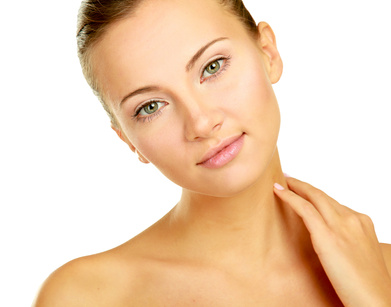
In dealing with undertones and overtones, this leads many women to confusion. When discussing these concerns with most women, they typically always refer to their shading as an undertone, when in reality it can be an overtone. Also it is best to avoid terms like "warm" and "cool" undertones as many women eventually discover this didn't help them end up with the correct shade. Such as; because they see pink they assume they are a cool, when in reality they are probably a warm tone. A blend of warm and cool when needed will actually make for a beautiful finished complexion.
DETERMINING WHAT FOUNDATION SHADE WORKS BEST FOR YOU
- Undertones: these are the underlying shades which give our skin its color tone and it comes from the melanin we possess in our skin. Melanin is typically yellow by nature in most women until you get to dark ethnic skin, which then will be yellow or red in undertones. Olive skin also possesses a lot of yellow combined with a green cast, but can lean red (pink) as the skin tone deepens. The fairer side of olive skin will typically appear to be a cool beige. Olive can also be an overtone when stronger yellow undertone is dominant. Also there are very fair women who still will have a strong yellow undertone, but it is less noticeable because they choose to avoid sun exposure, but once they burn, they will tan with continued sun exposure.
- Overtones: these are the shades our skin casts when we are exposed to sunlight, damage caused by sensitivity or irritation, acne, rosacea, cosmetic procedures and other maladies that cause our skin to get a pink tinge to it. Again, in fair skin the overtone can have a pink cast to it even with flawless skin, since fair skin possesses a translucent, almost colorless skin tone which causes the skin to appear slightly pinkish. Yet in some instances, women may think they are olive by mistake due to lack of pigment found in fair skin types. In most cases, those with fair skin should be aware, this does not mean your undertone is pink, but that you possess very little melanin, and in the absence of it, the face can appear pinkish, and this skin type burns easily and will rarely tan. Many redheads fall into this category and can have freckled skin to accompany this skin tone!
- Understanding True Fair Olive Skin: This has been historically a difficult shade of foundation for women to determine when they are in the fair to light skin tone range for olive shades. Determining your skin tone in this shade is crucial since when women are in the fair range, undertones are not as readily visible as described above. A ghost like appearance (gray pall) occurs when women purchase a fair olive shade when they are not a true olive. Basically, fair olive foundation is beige and appears neutral and works beautifully on fair olive skinned women. So if your undertone is anything else other than neutral, you will suffer with this very problem of trying to have a natural appearance.
How To Tell: So many women have been told to match their foundation shade to the jaw line carried up to the cheek. This is False! The face is where we have all of our damage from redness caused by so many things, including but not limited to broken capillaries, rosacea, acne and sun damage. All of these tend to tinge our skin reddish pink. This is not your undertone! This is the overtone of your skin. Plus it may require a mixture of two or more shades to achieve the perfect blend for your skin tone. Also be cautious of color correctors when using mineral makeup.

Best Place For Color Match: Stand in natural light with a mirror and look at your neck, shoulder, chest and inside of the upper arm. All of these areas will have different levels of exposure to sunlight.
The inside of the arm is the least exposed and has the best comparison to the other areas we suggest. Look at how your skin appears in each location.
A certain undertone will appear, whether it appears colorless (beige) which basically has no discernible hints of color (olive) except some yellow or pink.
You may see hints of yellow, combined with peach, pink, ivory, golden or reddish brown, all the way up to ebony, depending on if you are fair or someone who gets a bit of tan, or are of dark ethnic origin.
When this occurs, it distinguishes the melanin color within your skin.
See Mineral Makeup For Dark Ethnic Skin for assistance in this color range.
YOUR NATURAL SKIN TONE IS A COMPLEX BLEND OF SHADES THAT OUR MINERAL MAKEUP BEAUTIFULLY MIRRORS!
Example: When you tan you may turn golden brown or reddish brown. The latter means you have red and yellow melanin within your skin. This is how you want to choose a foundation shade, comparing the shading on these areas of the body, to the face. This is also why we do not create any true pink shades, but shades with undertones of yellow always and then shade with overtones of pink to address these variables within a skin tone. A true PINK shade ages the skins appearance and never looks natural.
You will know you are wearing the wrong shade, if your skin appears too light or too dark, chalky, looks like a mask compared to your neck, whether it be pink or yellow in tone, muddy, or other variables if when you look at your face it just seems to not blend with the other areas of the body. You'll know!
This is when sampling is most important in order to ascertain what skin tone you are when dealing with very fair to light skin. Until the color is applied, one may not actually realize their true undertones and overtones until the shade is sitting on the skin for comparison. Once the match is made, it is nothing short of breathtaking perfection!
Why Does This Work? Melanin is the key to proper selection and why you must look at undamaged areas of the skin along with the areas that receive sun exposure other than the face. Other areas of our bodies don't usually suffer from rosacea, acne or broken capillaries, and the skin on the face is easily damaged due to its thin structure, whereby being more readily changed, permanently.
Mineral Makeup Foundation is designed to correct this damage with the right color and coverage. So by wearing a shade which matches the face and jaw line, you are therefore enhancing the damage, whereas wearing a shade which blends flawlessly to the areas of the neck, chest and shoulders, you achieve correction with perfection.
Restore your youthful skin tone through proper shading with the correct base and add the subtle touches of shading through the use of gorgeous blushes, bronzer, lip colors and eye colors. Your face will never again compete with the rest of your body and will allow that healthy glow to shine through once more.
